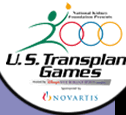|
The swimming meet might be the most revealing of
all the events at the Transplant Games. For starters,
the athletes are laid bare, with their tell-tale scars
easily visible
After a while, even an outsider learns how to read
them. If you see a small scar near the hip, that's
a kidney recipient. A "zipper" on the sternum tells
you they received a heart transplant, and a "w" indicates
a double-lung operation. Liver recipients, of course,
can be identified by the trademark "Mercedes Benz"
inverted "Y" on their chests.
|


|
| Saturday's swim meet also featured some
of the rawest displays of emotion anywhere during the
Games.
A lot of it was directed at Jackie Clare, 17, in
the form of affection. Clare contracted spina bifida
in her infancy, which weakened her legs. Although
she can walk with support -- she even entered the
50- and 100-meter track races -- to get around better
she often uses a wheelchair.
In 1997, Jackie's doctors told her she would need
dialysis in the short run and a kidney transplant
in the long run to live. Her family took a course
on how to perform dialysis at home in 1998, which
helped. "It was okay," Jackie says, "but I had good
days and bad days."
|
The clapping and cheering
grew with every determined little stroke.
|
|
|
The roller coaster finally flattened out when
her mom gave Jackie one of her kidneys on January 15, 1999.
"I'm a lot more energetic now," Jackie says. "I can do more
of the things I like."
Like most other eleventh-grade girls at Orlando's Evans
High, Jackie's list of things she likes includes -- surprise!
-- hanging out with her friends at the mall and talking
on the phone. She also appreciates "just going to school."
"I'm now in a work-study program," she says, "and I really
like that." Jackie's work-study duties entail engaging the
patients in conversation and mild physical therapy at the
Lutheran Towers Nursing Home. After high school she hopes
to pursue more job training and possibly attend college.
On this day, however, the task was less complicated: get
to the other side of the pool, and get back. She was not
the fastest swimmer in the 50-meter freestyle, but she was
cheered like an Olympic champion, receiving a standing ovation
when she finished. "Oh, I heard 'em!" she said. She added,
"my arms hurt, my shoulders hurt, but I've been getting
hugs and kisses from people I don't even know."
Not too many people anywhere in the world could fully
understand what Jackie felt at that moment, but Sharrod
Williams might be able to.
Sharrod was a normal nine-year-old African-American kid
growing up in Philadelphia when he was stricken with streptococcal
meningitis, which cost him the second halves of his arms
and legs. Nonetheless, the young man, now 18, swims every
day. "Every time I see that kid, he's got a smile on his
face," says James Gleason, who works with Williams and others
at Gift of Life in Philadelphia. "His attitude overcomes
all."
But Williams doesn't usually have an audience, and certainly
not one like the crowd at the pool on Saturday. There were
dozens of heats that day, and plenty of the buzz and confusion
that accompany any swim meet. But no matter what you were
doing at the pool when Williams started swimming, before
he finished you would have been watching.
The clapping and cheering grew with every determined little
stroke, until you couldn't help but notice the noise had
passed the usual threshold and was still growing. People
serving pizza, people processing earlier meets, people loitering
around the pool and people sitting in the balcony all stopped
their activities and conversations to crane their necks,
lean forward, stand up and move toward the pool to see what
the commotion was all about.
By the time Williams made the turn, getting just an occasional
lift on the stomach from Gift of Life worker Lynda McKeon,
he had the entire crowd's attention. He made his way slowly
down the lane, working furiously to stay afloat and reach
the wall. The crescendo of cheering was soon accompanied
by hundreds of red eyes and finally streams of tears. The
vast majority of spectators that day did not know the young
competitor's name, but they were moved to tears watching
Williams durable spirit propel him through the water.
When Williams emerged from the pool, the scene resembled
that of Lake Placid after the American hockey team had beaten
the Soviets: people cheering, clapping and pressing their
hands against their faces to mop up the tears.
You simply couldn't help it.
|

